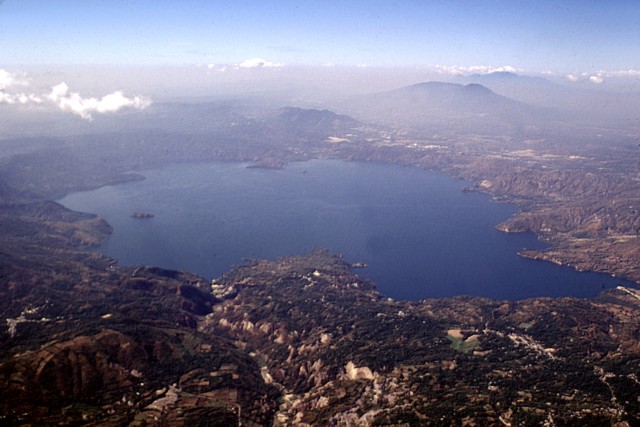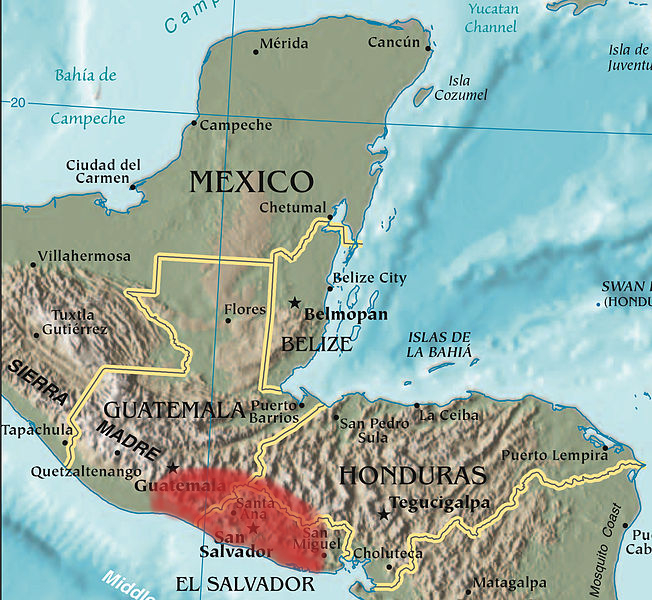TWH – Monday, a volcanic eruption in the Bay of Plenty on White Island in New Zealand was a terrible reminder of the devastation and loss of life a volcanic event can have. Recently, researchers have suggested that volcanic eruptions may also provide a good model for understanding past shifts in climate.
In 536 C.E. and again in 540 C.E., two different volcanoes erupted. These eruptions were so strong that they blocked sunlight, causing crops to fail, and driving famines throughout the Northern Hemisphere.
Recently, scientists have solved the mystery of which volcano erupted in 540 C.E. That eruption occurred in El Salvador, what was then the territory of Mayans. It may have also pushed parts of Europe into what is commonly referred to as the Dark Ages.

Lake that now fills the caldera of the Ilopango volcano – Image credit: Lee Siebert (Smithsonian Institution) – Public Domain – WikiCommons
Volcanic eruptions in 536 and 540 C.E.
Two separate volcanic eruptions occurred during the 6th century, one in 536 and another in 540 C.E. Debris and gas from the 540 C.E. eruption entered the atmosphere, joining the lingering debris and gas from the 536 C.E. eruption.
From 536 to 550 C.E., summers grew much colder in large parts of the world. These colder temperatures reduced the growing season. Famine ensued as a result. In Europe and the Mediterranean, the Late Antique Little Ice Age (536 to 660 C.E.) had begun. After 550 C.E., temperatures rose from those of the previous 14 years. And yet, it was still colder after 550 than it had been before 536 C.E.
Researchers believe the eruption of 536 C.E. occurred somewhere in Iceland or North America. No one has yet to link a specific volcano with this eruption. It occurred in the context of the collapse of the Western Roman Empire. Just 60 years earlier, Flavius Odoacer had deposed the last Western Roman Emperor and became the first King of Italy. Odoacer’s reign, which ended with his assassination in 493, is commonly seen as marking the end of the Western Roman Empire.
Core samples of polar ice have been found to contain evidence of those volcanic eruptions. Analysis of that evidence indicated that the 536 C.E. eruption had occurred in the temperate or arctic regions of the Northern Hemisphere. As the current climate change is diminishing the amount of polar ice, much of that evidence is melting away.
Scientists believe they have now located the volcano that erupted in 540 C.E. Polar ice data indicated that the 540 C.E. eruption occurred in the tropics around 15’ N latitude. Recently, scientists have found evidence that they believe pinpoints the Ilopango volcano, at 13.68’ N latitude, like the one that erupted in 539 or 540 C.E.
The intensity and impact of the 540 C.E. eruption
The 4-year interval between the eruptions magnified the impact of the second eruption. Debris from both eruptions combined to obscure sunlight. According to Dr. Robert Dull in the Quaternary Science Reviews, the Volcanic Explosivity Index rated the 540 C.E. eruption as a magnitude 7. For context, a magnitude 8 is the highest rating on that index. The 540 eruption ranks as one of the 10 strongest volcanic events in the past 7, 000 years.

Area of demographic collapse following the Ilopango eruption – Image credit: Tadam – WikiCommons
Dr. Tim Newfield of Princeton University in his Historical Climatology blog in 2016, detailed the various impacts of volcanic eruptions in the past. He also reported on the tree ring data from Ireland, Germany, Scandinavia, and the U.S. that all showed lessened growth from 536 through 546 C.E. The 540 C.E. eruption had the largest impact on these growth patterns.
Impacts in Central America
The Ilopango volcano erupted during the Maya Classic Period, in Mayan territory. Dr. Robert Dull discussed its impact in Quaternary Science Reviews. This eruption occurred “in a densely populated and intensively cultivated region of the southern Maya realm, causing regional abandonment of an area covering more than 20,000 km2 [square kilometers].”
Michael Greshko in National Geographic reported on the impact among the Maya. He reported a death rate of 40,000 to 80,000. Europe and the Mediterranean faced colder growing seasons and crop failure. Central America faced volcanic ash, gasses, pyroclastic flows, and rocks raining down. Besides the deaths among the Maya, famine and forced migration would have occurred. Around this time, monument construction among the Maya ceased. Construction, however, did resume, indicating that the Maya had recovered.
Impacts in the Mediterranean and northern Europe
Roman statesman and historian Cassiodorus, writing in the Eastern Roman Empire, described a dimmed moon, and a sun that had lost its “wonted light.” He said the sun appeared “bluish,” as if in “transitory eclipse throughout the whole year.”

Sun obscured by wildfire smoke -Image credit: Crenel – WikiCommons
Newfield reported that summers suddenly became much cooler from 536 to 550. Tree ring data indicate that some of the coldest growing seasons of the last 2000 years occurred during this period.
Six of the 13 coldest years between 500 B.C.E and 1250 C.E. occurred from 536 to 550 C.E. These colder and reduced growing seasons resulted in 14 years of crop failures. A starving populous is more susceptible to infection and the spread of disease. This may have contributed to the spread of The First Bubonic Plague Pandemic from 541 to 750 C.E.
The two successive volcanic eruptions of 536 and 540 disrupted large parts of the world. While the Mayan civilization appears to have recovered, the western parts of Europe did not.
The Wild Hunt is not responsible for links to external content.
To join a conversation on this post:
Visit our The Wild Hunt subreddit! Point your favorite browser to https://www.reddit.com/r/The_Wild_Hunt_News/, then click “JOIN”. Make sure to click the bell, too, to be notified of new articles posted to our subreddit.